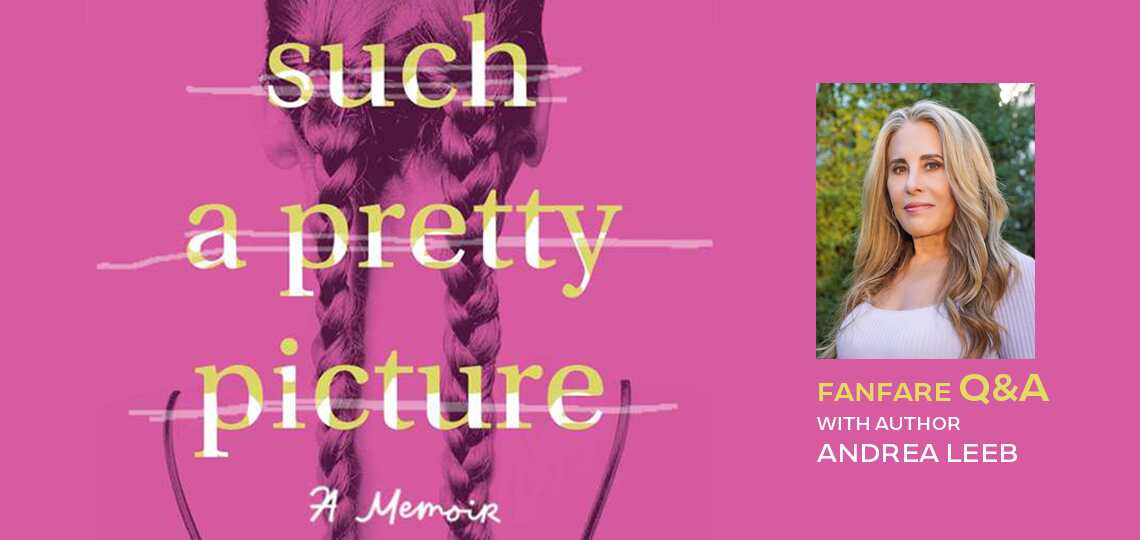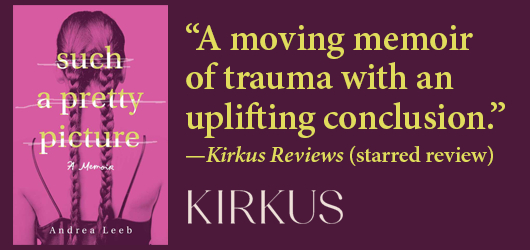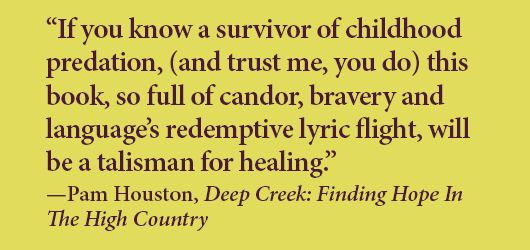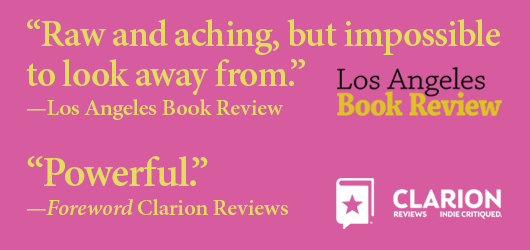"Raw and aching, but impossible to look away from."

Reviewer Suzanne Kamata Interviews Andrea Leeb, Author of Such a Pretty Picture: A Memoir
How you pick up the pieces after childhood sexual trauma is one of the most daunting challenges anyone will ever face because there’s no script, no tried and true path to recovery. In fact, recovery is anything but a guarantee.
Seeking to better understand how these courageous survivors move forward, today we’re with Andrea Leeb, author of a memoir about the abuse she suffered, its after effects, and the many years she struggled in search of healing. In the interview, we are heartened to learn that Andrea took great comfort in hearing stories from other victims and this spirit of paying it forward encouraged her to write Such a Pretty Picture—which earned a glowing Foreword Clarion review from Suzanne Kamata.
We are grateful to Andrea for taking the time to connect with Suzanne.
Enjoy the conversation.
What was the most difficult thing about writing and publishing this book?
The book was more difficult to write than I expected, especially because my mother was alive when I began writing. My relationship with my mother was complicated. I struggled with how to write honestly about her abuse and her complicity. She died before I finished the book, but even after her death, as the book’s publication date drew nearer, I grappled with feeling that telling my story was an act of betrayal to her. It was interesting for me, in the process of my journey, reckoning with my mother’s (in)actions, since I believed I had long since accepted that my mother, who I loved, had failed me, and that I had nothing to feel guilty about with writing my story for a public audience. That said, at this point, any doubts or feelings of guilt have receded. I am proud of the book, and I believe it will help raise awareness and empower other survivors to share their stories.
What was the most rewarding part of it?
The process of writing and speaking about Such A Pretty Picture has enabled me to be more open. I no longer hesitate to identify as an incest survivor. It has been rewarding to already see the impact of sharing my story. I’ve also had the opportunity to speak publicly on the issue of incest trauma and to join the UCLA Rape Treatment Center and Stuart House Advisory Board. I am now dedicating more of my time to advocacy and to volunteering at Stuart House, a program of the Rape Treatment Center that provides for the treatment of sexually abused children. The inspiration to engage in this work was an unexpected gift of writing this book.
Are there any particular writers or books that inspired or motivated you in the writing of this memoir?
In the early drafts of my writing process, I resisted reading or rereading books specifically exploring surviving childhood sexual abuse and incest. Given that I was still excavating my own past, I worried that reading the stories of others could color my own memories. There were, however, two books that I had read years before that inspired me to write Such A Pretty Picture.
I read Dorothy Allison’s Bastard Out of Carolina after leaving the inpatient program I describe in the third section of my book. Although Bastard Out of Carolina is a novel, I knew in my gut that the author was writing from experience. Reading it made me feel less alone. Although the book does not have a “tied-in-a-bow happy ending,” the book ends with Allison’s protagonist taking her first steps toward finding her own resilience. I was left with the assurance that healing was possible for me, too. I wanted my own book to give that gift to someone else too.
I was also inspired to tell my story from reading Sue Williams Silverman’s memoir, Because I Remember Terror Father, I Remember You. Silverman’s father, an influential banker and government official, sexually abused her from the age of four until eighteen. I read the book during a MFA program in the early 2000s, and I remember being astonished by the similarities between our lives. Even though I was focusing on short stories and fiction at the time, reading that memoir planted the seed that someday, when I was ready, I would tell my story, too. It took another ten years for me to begin but I am grateful to Sue Williams Silverman for paving the way.
While writing the book, I had the good fortune to study with a talented group of writers through the Writing by Writers Draft Program and later its Manuscript Bootcamp. Samantha Dunn, Josh Mohr, and Pam Houston each provided me with the wisdom, support, and encouragement I needed.
What would you tell your younger self?
I would tell my younger self that I am sorry that this happened to you but that it is not your fault. You are a victim of a terrible crime and the most profound betrayal by the people who were supposed to protect you. I would tell her to be kind to herself. That no matter how resilient she thinks she is she needs to get help. I would encourage her to get therapy as soon as possible and tell her that with help it is possible to heal and even find joy. And finally, and perhaps most importantly, I would tell her I love her.
Has writing the book helped you to heal and how are you feeling after having launched it into the world?
People often ask me that question. By the time I started writing this book, I’d had decades of therapy. It would’ve been dangerous to excavate these memories without a solid foundation of recovery. But as I explain in my book, “healing is not linear.”
Writing Such a Pretty Picture has allowed me to continue to heal on a deeper level. In truth, nothing can completely eradicate the pain of incest, but with therapy and a supportive community, I’ve found healing and even joy. As the book is nearing publication, I feel grateful that I’ve been able to turn my personal trauma into something positive. If my book gives one person the courage to seek out help and empowers them to believe that healing is possible, then I have succeeded.
You are donating a portion of the royalties from this memoir to RAINN. Could you explain a bit about this organization and why you chose it as your beneficiary?
RAIIN (Rape, Abuse & Incest National Network) is America’s largest anti-sexual violence organization. Although I mention donating to RAINN in the back of my book, I am also giving the remaining seventy-five percent of my royalites to a variety of other organizations that provide services to victims of sexual violence. Many of those including the UCLA Rape Treatment Center and Stuart House (which provides services to children), where I serve on the advisory board, operate on the local or state level. I called out RAINN because it operates on a national level. Among other services RAINN provides, it operates a national hotline (1-800-656-Hope) in partnership with one thousand local sexual assault providers across the country. According to its website, RAINN has provided help to over 4.5 million survivors and their loved ones.
What’s next? Are you working on another book?
I have been working on new essays, and I recently pulled a partially written novel out of the drawer, whose possibilities I have been exploring. In truth, the authoring process (as opposed to the writing process) has been so consuming I am finding it hard to focus on anything unrelated to Such A Pretty Picture. I plan to write a second book but at this point I am not sure what that book will look like.
Such a Pretty Picture
A Memoir
Andrea Leeb
Amazon KDP (Oct 14, 2025)
Clarion Rating: 4 out of 5
Such a Pretty Picture is a shocking memoir about surviving sexual abuse.
Andrea Leeb’s powerful memoir Such a Pretty Picture explicates the long-term consequences of and process of recovery from abuse.

As a graduate student and later as a university instructor, Leeb’s father was a respected member of society. In the privacy of his home, however, he molested his daughter. Although Leeb’s mother witnessed an incident firsthand and suffered from temporary blindness as a result, she ignored the indications of ongoing abuse. Leeb learned that, to hang on to her mother’s love, she had to remain compliant. Meanwhile, her younger sister Sarai was hit by their father.
Although the abuse ended in Leeb’s adolescence, its effects, including occasional suicidal ideation and bouts of depression, endured. As a teenager, Leeb found herself in vulnerable situations with boys, unable to defend herself from groping hands. Later, it was difficult for her to commit to long-term relationships. She was twice divorced after short marriages.
The abuse begins on the first page, with a shocking scene in which Leeb’s father masturbates while giving his four-year-old daughter a bath. The event, relayed from the point of view of a little girl who doesn’t understand what is happening, has clear implications. As Leeb grew older, her awareness of the wrongness of her father’s touching and her sense of helplessness increased. In time with this growing introspection, a sense of dread and anxiety permeates the pages.
The prose is direct and unvarnished, covering with clarity how Leeb gave in to her father’s demands to tamp down his temper. Anguish is conveyed in scenes as of Leeb being sent to a psychiatrist for exhibiting signs of stress; when she hinted at what was happening to her, the doctor dismissed her words and reported them to her parents, rendering her even more powerless and distrustful.
The memoir is novelistic in structure, with remembered conversations reconstructed as dialogue. Period details like halter tops, beehive hairdos, and Pink Floyd playing on cassette tapes, as well as references to events such the assassination of President Kennedy and Leeb’s parents’ participation in antiwar protests, flesh out the 1960s–1970s setting well. And although it covers harrowing experiences at length, the book ends on a hopeful note, with Leeb seeking ways to heal.
Such a Pretty Picture is a raw memoir about incestuous abuse. Its pages underscore the damage that continues in the aftermath of such trauma.
Reviewed by Suzanne Kamata
May 27, 2025
Suzanne Kamata



